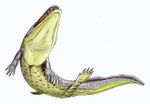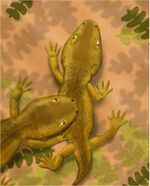Earth:Fremouw Formation
| Fremouw Formation Stratigraphic range: latest Permian-early Late Triassic252–235 Ma | |
|---|---|
| Type | Geological formation |
| Unit of | Beacon Supergroup |
| Sub-units | Lower, middle, upper |
| Underlies | Falla Formation |
| Overlies | Buckley Formation |
| Thickness | up to 1,000 m (3,300 ft) |
| Lithology | |
| Primary | Sandstone, siltstone, mudstone |
| Location | |
| Coordinates | [ ⚑ ] : 84°00′00″S 165°00′00″E / 84.0000°S 165.0000°E |
| Paleocoordinates | [ ⚑ ] 81°48′S 69°48′E / 81.8°S 69.8°E |
| Region | Transantarctic Mountains of Antarctica |
| Type section | |
| Named for | Fremouw Peak, Queen Alexandra Range, Antarctica.[1] |
| Named by | P. J. Barrett[1] |
The Fremouw Formation is a Triassic-age rock formation in the Transantarctic Mountains of Antarctica. It contains the oldest known fossils of tetrapods from Antarctica, including synapsids, reptiles and amphibians. Fossilized trees have also been found. The formation's beds were deposited along the banks of rivers and on floodplains. During the Triassic, the area would have been a riparian forest at 70–75°S latitude.
Stratigraphy
The Fremouw Formation is mostly Triassic in age, with the oldest rocks dating back to the latest Permian. Much of the formation is quartzose sandstone that was deposited in stream beds.[2] It overlies the Permian Buckley Formation, which consists of coal and Glossopteris fossils.[3] The formation is informally divided into lower, middle, and upper units. Most fossils are found in the Lower Fremouw Formation. Here, bones are preserved in fine-grained siltstones and mudstones, coarse-grained channel sandstones, and conglomerates.[4]
Paleoenvironment

Well-preserved plants are common in the Fremouw Formation. Logs have been found in channel deposits, and roots and stems have been found in permineralized soil. Smaller fossils on Fremouw Peak include cycads, horsetails, seed ferns, Osmundaceae ferns, and even fungi. One cycad called Antarcticycas is similar in appearance to the living Bowenia of Australia .[5] In 2003, 99 fossilized tree trunks were described from Gordon Valley. These trunks comprise an intact fossilized forest, allowing for an estimation of the distribution of plants and tree cover. Dicroidium fossils are present around the conifer-like stumps, suggesting that they were the leaves of these large trees.[6] Based on the geology of the area, the trees grew alongside riverbanks and on floodplains. The structure of the plants shows no adaptation towards cold tolerance, suggesting that the climate was much warmer in the Triassic.[5]
The Fremouw Formation preserves many tetrapod fossils that span the Permo-Triassic boundary, which marks the Permo-Triassic mass extinction. Around the world, the fossil record of many tetrapod groups is absent or very limited in Early Triassic rocks, implying a major decline in diversity after the extinction. The presence of many of these groups in Middle Triassic strata indicates that long ghost lineages must have extended back into the Early Triassic. Tetrapods such as temnospondyl amphibians, diapsid reptiles, and dicynodont therapsids were common in the Late Permian and seemed to have recovered by the Middle Triassic, but there is little record of their presence in the Early Triassic. All of these tetrapods are present in Early Triassic strata of the Fremouw Formation, suggesting that Antarctica served as a refugium for these animals. During the extinction, global temperatures rose and the supercontinent Pangea moved northward, putting pressure on populations that could not adapt to the warming climate. Antarctica, while much warmer in the Early Triassic than it is today, was cooler than other parts of Gondwana and may have been more hospitable to tetrapod populations. Antarctica's milder climate allowed many groups to take refuge in the region while other populations experienced decline. In the Early Triassic, many Fremouw Formation tetrapods had smaller body sizes than their Permian ancestors, and many were adapted for burrowing. Both of these characteristics are seen as adaptations to Antarctica's greater seasonal variability and protracted day-night cycles.[7]
Biota
The first tetrapod, or land-living vertebrate, from Antarctica was found in the Fremouw Formation and described in 1968. It was represented by a small bone fragment that is probably part of the left mandible of a temnospondyl amphibian.[3] The bone was found the previous year by a researcher from Ohio State University who was studying the geology of the Transantarctic Mountains.[8] The animal was later named Austrobrachyops Jenseni. After its discovery, paleontological expeditions were launched to the area around the Beardmore Glacier to uncover more fossils. Since then, fragmentary remains of temnospondyls, therapsids, and archosauriform reptiles have all been found in the formation.[9] These fossils are found around the Shackleton and Beardmore glaciers, in places such as Gordon Valley and Fremouw Peak.
Tetrapods
Temnospondyls
| Taxon | Species | Member | Material | Notes | Images |
|---|---|---|---|---|---|
|
Austrobrachyops |
A. jenseni[8] |
Lower Fremouw |
Jaw fragment, pterygoid bone, and other small fragments |
A nomen dubium based on a combination of material from brachyopid temnospondyls, a dicynodont, and other animals[9] |
|
| Antarctosuchus |
A. polyodon |
Upper Fremouw |
A mostly complete skull |
A capitosaur temnospondyl |
|
| Cryobatrachus |
C. kitchingi[8] |
Lower Fremouw |
A partial skull and other bone fragments |
A lydekkerinid temnospondyl |
|
| Kryostega |
K. collinsoni[10] |
Upper Fremouw |
Large snout fragment |
A stereospondyl temnospondyl |
|
| Micropholis | M. stowi[11] | Lowe Fremouw | A block containing the skeletons of 4 individuals of the taxon, accounting for much of the skeletons. | A Euskelian temnopodyl | |
| Parotosuchus |
P. sp.[9] |
Upper Fremouw |
Fragment of the right side of the snout. |
A temnospondyl |
|
| Rhigerpeton | R. isbelli[12] | Lower Fremouw | Partial skull | A lapillopsid temnospondyl | |
| Rhytidosteidae |
R. indet.[4] |
Lower Fremouw |
A temnospondyl |
Reptiles
| Taxon | Species | Member | Material | Notes | Images |
|---|---|---|---|---|---|
| Antarctanax |
Lower Fremouw |
Eight presacral vertebrae, left humerus, ribs, feet |
Medium-sized archosauriform |
||
| Archosauriformes | Indeterminate.[14] |
Lower Fremouw |
A large-bodied archosauriform reptile |
||
| Palacrodon |
P. browni[14] |
Lower Fremouw |
An enigmatic diapsid reptile; initially named Fremouwsaurus geludens |
||
| Procolophon |
Lower Fremouw |
A procolophonid reptile |
|||
| Prolacerta |
Lower Fremouw |
A prolacertiform reptile |
Synapsids
| Taxon | Species | Member | Material | Notes | Images |
|---|---|---|---|---|---|
| Cynognathus |
Cynognathus sp.[15] |
Upper Fremouw |
A cynodont |
||
| Impidens |
Upper Fremouw |
Partial snout |
A cynodont, originally described as Diademodontidae indet.[15] |
||
| Ericiolacerta |
Lower Fremouw |
||||
| Kannemeyeriidae | Indeterminate.[15] |
Upper Fremouw |
|||
| Kombuisia | K. antarctica[7] |
Lower Fremouw |
A dicynodont |
||
| Lystrosaurus |
Lower Fremouw |
A dicynodont |
|||
|
Lower Fremouw |
A dicynodont |
||||
| Myosaurus |
Lower Fremouw |
A dicynodont |
|||
| Notictoides | N. absens [19] | A therocephalian | |||
| Pedaeosaurus |
Lower Fremouw |
A therocephalian |
|||
| Rhigosaurus |
Lower Fremouw |
A therocephalian |
|||
| Thrinaxodon |
Lower Fremouw |
A cynodont |
See also
- List of fossiliferous stratigraphic units in Antarctica
References
- ↑ 1.0 1.1 Barrett, P.J., 1969, Stratigraphy and petrology of the mainly fluviatile Permian and Triassic Beacon rocks, Beardmore Glacier area, Antarctica. Ohio State University Institute of Polar Studies Report 34, pp1-132 .
- ↑ Elliot, D.H.; Colbert, E.H.; Breed, W.J.; Jensen, J.A.; Powell, J.S. (1970). "Triassic tetrapods from Antarctica: evidence for continental drift". Science 169 (3951): 1197–1201. doi:10.1126/science.169.3951.1197. PMID 17815934. Bibcode: 1970Sci...169.1197E.
- ↑ 3.0 3.1 Barrett, P.J.; Baillie, R.J.; Colbert, E.H. (1968). "Triassic amphibian from Antarctica". Science 161 (3840): 460–462. doi:10.1126/science.161.3840.460. PMID 5659679. Bibcode: 1968Sci...161..460B.
- ↑ 4.0 4.1 4.2 "Background". Transantarctic Vertebrate Paleontology Project. Augustana College. 2008. http://www.antarcticvp.com/background.html. Retrieved 13 July 2011.
- ↑ 5.0 5.1 Taylor, E.L.; Taylor, T.N. (1993). "Fossil tree rings and paleoclimate from the Triassic of Antarctica". in Lucas, S.G.. The Nonmarine Triassic. Albuquerque: The New Mexico Museum of Natural History and Science Bulletin. pp. 453–455. http://work.geobiology.cn/ebook/%E8%8B%B1%E6%96%87%E6%96%87%E7%8C%AE/The%20Nonmarine%20Triassic/80%20Fossil%20Tree%20Rings%20and%20Paleoclimate%20from%20the%20Triassic%20of%20Antarctica.pdf.
- ↑ Cúneo, N.R.; Taylor, E.L.; Taylor, T.N.; Krings, M. (2003). "In situ fossil forest from the upper Fremouw Formation (Triassic) of Antarctica: paleoenvironmental setting and paleoclimate analysis". Palaeogeography, Palaeoclimatology, Palaeoecology 197 (3–4): 239–261. doi:10.1016/s0031-0182(03)00468-1. Bibcode: 2003PPP...197..239C.
- ↑ 7.0 7.1 Fröbisch, J.; Angielczyk, K.D.; Sidor, C.A. (2010). "The Triassic dicynodont Kombuisia (Synapsida, Anomodontia) from Antarctica, a refuge from the terrestrial Permian-Triassic mass extinction". Naturwissenschaften 97 (2): 187–196. doi:10.1007/s00114-009-0626-6. PMID 19956920. Bibcode: 2010NW.....97..187F.
- ↑ 8.0 8.1 8.2 Colbert, E.H.; Cosgriff, J.W. (1974). "Labyrinthodont amphibians from Antarctica". American Museum Novitates (2552): 1–30.
- ↑ 9.0 9.1 9.2 Sidor, C.A.; Steyer, J.S.; Damiani, R. (2007). "Parotosuchus (Temnospondyli: Mastodonsauridae) from the Triassic of Antarctica". Journal of Vertebrate Paleontology 27 (1): 232–235. doi:10.1671/0272-4634(2007)27[232:PTMFTT2.0.CO;2].
- ↑ Sidor, C.A.; Damiani, R.; Hammer, W.R. (2008). "A new Triassic temnospondyl from Antarctica and a review of Fremouw Formation biostratigraphy". Journal of Vertebrate Paleontology 28 (3): 656–663. doi:10.1671/0272-4634(2008)28[656:ANTTFA2.0.CO;2].
- ↑ Gee, Bryan M.; Sidor, Christian A. (2021-05-21). "First record of the amphibamiform Micropholis stowi from the lower Fremouw Formation (Lower Triassic) of Antarctica". Journal of Vertebrate Paleontology 41: e1904251. doi:10.1080/02724634.2021.1904251. ISSN 0272-4634.
- ↑ Gee, Bryan M.; Beightol, Charles V.; Sidor, Christian A. (2023-06-28). "A new lapillopsid from Antarctica and a reappraisal of the phylogenetic relationships of early diverging stereospondyls" (in en). Journal of Vertebrate Paleontology. doi:10.1080/02724634.2023.2216260. ISSN 0272-4634. https://www.tandfonline.com/doi/full/10.1080/02724634.2023.2216260.
- ↑ Peecook, Brandon R.; Smith, Roger M. H.; Sidor, Christian (2019). "A novel archosauromorph from Antarctica and an updated review of a high-latitude vertebrate assemblage in the wake of the end-Permian mass" (in en). Journal of Vertebrate Paleontology: 1–16. doi:10.1080/02724634.2018.1536664. ISSN 0272-4634.
- ↑ 14.0 14.1 14.2 14.3 Smith, N.D.; Crandall, J.R.; Hellert, S.M.; Hammer, W.R.; Makovicky, P.J. (2011). "Anatomy and affinities of large archosauromorphs from the lower Fremouw Formation (Early Triassic) of Antarctica". Journal of Vertebrate Paleontology 31 (4): 784–797. doi:10.1080/02724634.2011.586662. http://pubs.usgs.gov/of/2007/1047/ea/of2007-1047ea047.pdf.
- ↑ 15.0 15.1 15.2 Hammer, W.R. (1995). "New therapsids from the Upper Fremouw Formation (Triassic) of Antarctica". Journal of Vertebrate Paleontology 15 (1): 105–112. doi:10.1080/02724634.1995.10011210.
- ↑ Tolchard, Frederick; Kammerer, Christian F.; Butler, Richard J.; Hendrickx, Christophe; Benoit, Julien; Abdala, Fernando; Choiniere, Jonah N. (2021-07-26). "A new large gomphodont from the Triassic of South Africa and its implications for Gondwanan biostratigraphy". Journal of Vertebrate Paleontology 41 (2): e1929265. doi:10.1080/02724634.2021.1929265. ISSN 0272-4634. https://doi.org/10.1080/02724634.2021.1929265.
- ↑ 17.0 17.1 17.2 Colbert, E.H.; Kitching, J.W. (1981). "Scaloposaurian reptiles from the Triassic of Antarctica". American Museum Novitates (2709): 1–22.
- ↑ 18.0 18.1 Colbert, E.H. (1974). "Lystrosaurus from Antarctica". American Museum Novitates (2535): 1–44. http://digitallibrary.amnh.org/dspace/bitstream/handle/2246/5462//v2/dspace/ingest/pdfSource/nov/N2535.pdf?sequence=1.
- ↑ Sidor, Christian A.; Kulik, Zoe T.; Huttenlocker, Adam K. (2021-10-01). "A new bauriamorph therocephalian adds a novel component to the Lower Triassic tetrapod assemblage of the Fremouw Formation (Transantarctic Basin) of Antarctica" (in en). Journal of Vertebrate Paleontology 41 (6): e2081510. doi:10.1080/02724634.2021.2081510. ISSN 0272-4634. https://www.tandfonline.com/doi/full/10.1080/02724634.2021.2081510.
- ↑ Colbert, E.H.; Kitching, J.W. (1977). "Triassic cynodont reptiles from Antarctica". American Museum Novitates (2611): 1–30.
 |














